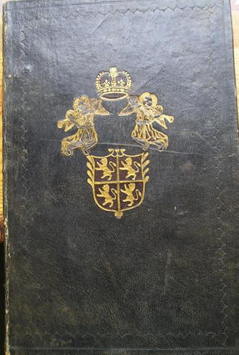 Arms of Morrison impaling Webb covering 1709 Eusebia Triumphans Call number: RHT 17th-773 |
Illustrated here are Settle bindings. Howard Nixon (1909-1983), in his Five Centuries of English Bookbinding, describes these, with some disdain:
“Elkanah settle, who was born in 1640 and had been hailed as a rising playwright in the 1670’s, had dwindled by the end of the century into a hack versifier holding the unremunerative post of ‘City Poet.’ In 1700 he started to work what can only be described as a successful racket, which he carried on for the rest of his life. He composed topical poems, at first on political events and later on more personal subjects such as births, deaths and marriages in the families of the great and wealthy. They were put into leather bindings with elaborate (if not very good) gold tooling embellished with the arms of the likely patron, to whom they were dispatched in hopes of a suitable reward. Should the reward not be forthcoming and the book be returned to Settle, he had the original recipient’s arms covered with a leather only on which were then tooled those of a suitable candidate.”

Settle’s letter of presentation once pinned into a copy of his 1707 Carmen Irenicum inscribed on the title page: “Ex Libris Edwardi Haistwell xvto Cal. Martis 1710.”
“Sir: Be pleased to give me Leave to make you once mre an humble present, on this great subject, the Union of the Two Kingdoms; hoping it may find Your Acceptance from Your most obliged and most humble Servant. E: Settle.”
Call number: RHT 17th-785.
Gathered within them, there is much to analyze, be it social, cultural, or design history. Created as objects for presentation to nobility, they raise many questions surrounding such objects. Recipients range from earls down through the ranks to knights and wealthy merchants. So, why was a particular recipient chosen? Was the present planned to initiate a connection or to sustain one already formed? Did the present result in an exchange for Settle? Did he obtain any remuneration for his art?
One exception to this corner ornament pattern has been found. Covering a 1703 poem, the binding consists of the typical perimeter frame and inner frame ornamented at corners. Rather than the expected flower tool, the corner tool is the thistle. In addition, no arms are present. What can be made of these incongruities? Rather than being a binding made contemporaneous with the imprint it covers, perhaps this is a ‘blank’ prepared ca. 1707 as a trial effort for the new thistle tool.
Why this elimination occurs is only a matter of speculation: perhaps the sparer layout was regarded as more chaste or perhaps removal of the inner frame was intended to focus keener attention on arms of such high rank.
Gallery of images available at
http://www.flickr.com/photos/08544-sf/sets



